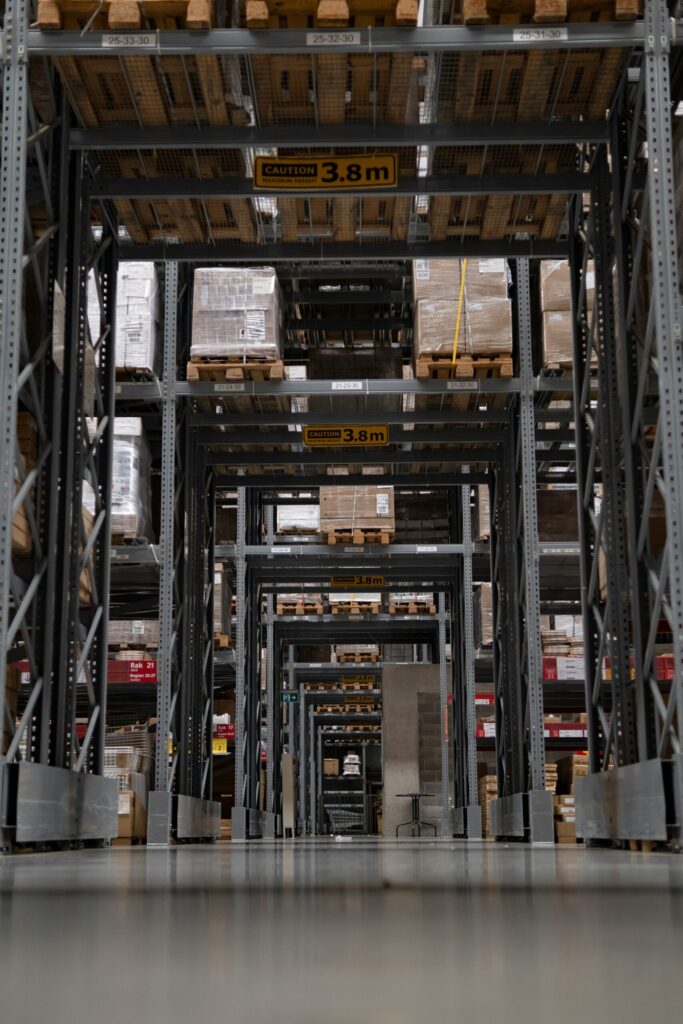From the port to your front porch, logistics is what turns supply chains from theory into reality. It’s a massive field. We’re talking warehouse associates, forklift operators, dispatchers, freight brokers, inventory analysts, transportation managers, import/export specialists, network designers—all of them fall under the logistics umbrella.
And here’s the thing: if you want a career with measurable results, clear promotion paths, and constant hiring, logistics delivers. Literally.
This guide breaks down the roles, the pay, the tools you’ll actually use, certifications that matter, where the jobs are concentrated, and how to break in—whether you’re starting on the warehouse floor, coming from customer service, or pivoting from a data or operations background.
Read Also: Hobby Lobby Jobs in the USA (2025 Guide)
What logistics actually means (what you’ll touch every day)
 Logistics covers the entire flow of goods. Inbound operations—receiving shipments, putting them away in the right spots. Storage—figuring out where products should live in the warehouse (slotting) and keeping shelves stocked (replenishment). Order fulfillment—picking items, packing boxes, shipping them out. Transportation—moving freight via full truckload (FTL), less-than-truckload (LTL), parcel carriers, or last-mile delivery. Reverse logistics—handling returns, refurbishing products, and managing damaged goods. And network design—the strategic work of deciding where warehouses and distribution centers should be located and how routes should flow.
Logistics covers the entire flow of goods. Inbound operations—receiving shipments, putting them away in the right spots. Storage—figuring out where products should live in the warehouse (slotting) and keeping shelves stocked (replenishment). Order fulfillment—picking items, packing boxes, shipping them out. Transportation—moving freight via full truckload (FTL), less-than-truckload (LTL), parcel carriers, or last-mile delivery. Reverse logistics—handling returns, refurbishing products, and managing damaged goods. And network design—the strategic work of deciding where warehouses and distribution centers should be located and how routes should flow.
Employers range from shippers (retailers, e-commerce companies, manufacturers who move their own products) to 3PLs and 4PLs (third-party and fourth-party logistics providers who run warehouses and transport for other companies), parcel integrators like UPS and FedEx, freight brokers, import/export firms, ports, and rail companies.
Why does hiring persist even when the economy wobbles? E-commerce created a permanent baseline demand. Reshoring and nearshoring shift where freight flows, but they don’t reduce the need for people who actually run warehouses and manage fleets. And automation? It’s adding new tech-enabled roles alongside the classic floor jobs, not replacing everything.
Read Also: Scrum Master Jobs in the USA (2025 Guide)
Salary and outlook for Logistics Jobs (how the money actually works)
Pay varies with your shift, location, industry, and level of responsibility. These are directional 2025 ranges—cross-check with local job postings in your area because geography makes a huge difference.
Entry-level (starting on the floor)
Warehouse Associate / Picker / Packer: $16–$23/hour base. Overtime is common, especially during peak seasons (Q4, Prime Day, back-to-school), and that bumps your actual take-home significantly. Second and third shift typically add $1–$3/hour on top of base pay.
Forklift/Reach/Order Picker Operator (powered industrial truck, or PIT): $18–$26/hour. You’ll earn premiums for specialized equipment—high-reach trucks, turret trucks, very-narrow-aisle machines—or for working in freezer environments. Cold storage work can add $2–$4/hour because, well, it’s miserable.
Non-CDL Delivery (box trucks, last-mile routes): $18–$25/hour. Some segments offer tips (furniture delivery, appliance installation). Overtime is common because routes don’t always finish in eight hours.
Read Also: Workers’ Compensation Attorneys in the USA
Skilled and licensed logistics jobs
CDL-A Driver (regional or over-the-road): $60k–$95k+ annually. This includes base pay, per-mile rates, and bonuses. Specialized endorsements—hazmat, refrigerated (reefer), flatbed—can push you higher. Dedicated routes with predictable home time often pay less than OTR, but you’re sleeping in your own bed more often.
Maintenance Technician (material handling equipment, conveyors, automated storage and retrieval systems): $28–$42/hour. Night shift coverage commands a premium because when a conveyor goes down at 2 AM during peak season, someone needs to fix it immediately.
Inventory Control / Cycle Counter: $20–$28/hour. This role is a natural stepping stone into analyst positions because you’re already working with data, investigating discrepancies, and understanding how the warehouse management system (WMS) works.
Coordinator and analyst roles
Logistics Coordinator / Dispatcher: $45k–$70k annually. Higher if you’re on-call or working after-hours support. You’re the person coordinating shipments, communicating with drivers and customers, and solving problems in real-time.
Transportation or Logistics Analyst: $60k–$90k. SQL and business intelligence (BI) skills push you toward the upper range. You’re pulling data, building dashboards, identifying cost savings, and making recommendations that actually affect the bottom line.
Import/Export Specialist / Customs Entry Writer: $52k–$80k. Compliance experience and deep knowledge of Harmonized Tariff Schedule (HTS) classifications add significant value. Companies will pay more for someone who can keep them out of trouble with Customs and Border Protection.
Management
Warehouse or Transportation Supervisor: $60k–$90k, plus shift premiums and bonuses tied to performance metrics.
Operations or Logistics Manager: $85k–$130k+. Bonuses are typically tied to on-time in-full delivery (OTIF), cost per order, and safety metrics. Hit your numbers, and your total comp can jump significantly.
Director of Logistics / Network Design: $120k–$180k+. At growth companies (especially e-commerce or tech), you might see equity on top of base salary.
Read Also: Workers’ Compensation Attorneys in the USA
What pays higher
 Cold chain and freezer environments. Weekend and night shifts. Holiday peak seasons. Hazmat endorsements. High-volume operations during rapid growth phases. And—this is huge—proven KPI improvements you can document. If you can show you lifted cases per hour (CPH), reduced dock-to-stock time, or improved OTIF by measurable points, you’ve got leverage.
Cold chain and freezer environments. Weekend and night shifts. Holiday peak seasons. Hazmat endorsements. High-volume operations during rapid growth phases. And—this is huge—proven KPI improvements you can document. If you can show you lifted cases per hour (CPH), reduced dock-to-stock time, or improved OTIF by measurable points, you’ve got leverage.
Job families and what you’ll actually do every day
Let me break down the main career tracks, the tools you’ll use, the metrics you’ll be measured on, and how you move up.
A) Warehouse and fulfillment
Roles: Warehouse Associate, Picker, Packer, Replenishment Tech, Inventory Control Specialist, Shipping/Receiving Clerk, Returns Processor, Lead, Supervisor.
Tools you’ll use: RF scanners (those handheld devices you scan barcodes with), warehouse management systems like Manhattan, Blue Yonder, or Odoo, pick modules (the tall shelving units you navigate), conveyor systems, automated storage and retrieval systems (AS/RS), powered industrial trucks, and safety programs like lockout/tagout (LOTO).
KPIs you’re measured on: Cases per hour (CPH), pick rate, dock-to-stock time (how fast incoming freight gets put away), inventory accuracy, damage rate, and safety metrics like Total Recordable Incident Rate (TRIR).
Career path: You start as an Associate, get PIT-certified to operate forklifts and reach trucks, move into Inventory Control or a Lead position, then Supervisor, and eventually Operations Manager. The fastest way up? Cross-train. Learn cycle counting, replenishment, and shipping. Don’t just stay in picking your entire first year.
How to stand out: Track your own numbers. Know your CPH, your pick error rate, and your damage rate. Volunteer for slotting projects (reorganizing where products live in the warehouse) and cycle counts (the ongoing inventory audits). Learn basic Excel so you can analyze, pick paths, and identify error trends. Supervisors notice people who care about the data, not just the work.
Here’s what most people don’t realize about warehouse work: the physical demands are real, but they’re manageable if you pace yourself and use proper technique. I’ve seen people burn out in three months because they sprint through their first week trying to impress, then their back gives out. Steady, sustainable pace beats heroics. And seriously, invest in good boots and insoles. Your feet and knees will thank you.
Read Also: How to Maximize Success in the $10,000 USA Visa Sponsorship Program
B) Transportation and last-mile delivery
Roles: CDL-A or CDL-B Driver, Non-CDL Delivery Driver, Dispatcher, Route Planner, Transportation Supervisor, Transportation Manager.
Tools: Transportation management systems (TMS) like Oracle or MercuryGate, electronic logging devices (ELD) and telematics, routing software like Paragon or Routific, driver vehicle inspection reports (DVIR), hours of service (HOS) compliance tracking.
KPIs: On-time in full (OTIF), on-time percentage, cost per mile or cost per stop, claims percentage (damage and loss).
Career path: Start as a Dispatcher, move into Route Planning, then Transportation Manager. Or start as a Driver, become a Driver Trainer, move into Fleet Supervisor, then Transportation Manager. Both paths work—one’s office-based, one starts on the road.
How to stand out: Reduce detention time (when trucks sit waiting to be loaded or unloaded—it’s expensive). Cut empty miles (deadhead). Improve tender acceptance rates with carriers. Maintain pristine DVIR records. Build relationships with your carrier reps—those connections matter when capacity gets tight.
Dispatching is stressful. You’re juggling driver personalities, customer expectations, traffic delays, weather, breakdowns, and hours-of-service regulations all at once. The good dispatchers stay calm, communicate clearly, and solve problems instead of panicking. If you can keep your head during a holiday week when three drivers call in sick and a snowstorm hits the Midwest, you’ll move up fast.
Read Also: Jobs that make $3000 a month without a Degree
C) Freight brokerage and carrier sales
Roles: Freight Broker, Freight Agent, Carrier Sales Rep, Account Manager.
Tools: Load boards like DAT and Truckstop, TMS with CRM functionality, margin math (constantly calculating what you can pay carriers vs. what customers will pay you), EDI, and API systems for automated tendering.
KPIs: Gross margin percentage, loads booked per month, tender acceptance rate, and claims rate.
Career path: Start as a Junior Broker or in career sales, build your book of business, move into Account Manager, then potentially Branch Manager, or start your own brokerage.
Proof of success: A solid book of business, career scorecards showing reliability, and consistent monthly margins. Brokers live and die by their numbers.
Brokerage is high-pressure sales. You’re negotiating with carriers on one side and customers on the other, trying to make a margin in the middle. Some people thrive on it—the autonomy, the earning potential (good brokers make six figures), the deal-making. Others hate it. If you’re not comfortable with cold calls, rejection, and daily negotiation, this probably isn’t your track. But if you like the hustle? It can be incredibly lucrative.
Read Also: Physical Therapy Assistant Jobs in the USA
D) Inventory, planning, and analytics
Roles: Logistics Coordinator, Inventory Analyst, Transportation Analyst, Network Analyst.
Tools: Excel and Power Query, SQL for database queries, business intelligence platforms like Power BI or Tableau, WMS and TMS data extracts, basic Python for analysis (increasingly common).
KPIs: Forecast accuracy, fill rate, cube utilization (how efficiently you’re using warehouse space), dwell time, detention costs.
Career path: Start as a Coordinator, move to Analyst, then Senior Analyst, potentially into Network Design or Continuous Improvement roles, then Manager or Director.
Proof of success: Build a dashboard. Write SQL queries that pull and clean data. Complete a cost-per-order or OTIF improvement project with documented results. That portfolio gets you promoted.
The analyst track is where you go if you like solving puzzles with data more than managing people. You’re digging into why OTIF dropped two points last month, or why a certain warehouse has higher damage rates, or how to reduce transportation costs by optimizing the carrier mix. It’s less physically demanding than floor work, but you need to be comfortable with numbers and teaching yourself new tools.
E) Import/export and trade compliance
Roles: Customs Entry Writer, Import/Export Specialist, Trade Compliance Analyst.
Tools: HTS classification codes, the ACE (Automated Commercial Environment) portal, ISF (Importer Security Filing) and AMS (Automated Manifest System) filings, INCOTERMS (international commercial terms), and denied-party screening tools.
KPIs: Customs clearance time, penalty avoidance, audit pass rate, classification accuracy.
Career path: Start as an Entry Writer, move to Senior Specialist, then Compliance Analyst, and eventually Manager of trade compliance.
Proof of success: Zero-penalty audits, high classification accuracy, documented cycle-time improvements in customs clearance.
Trade compliance is detail-oriented work with serious consequences for mistakes. Misclassify a product or miss a denied-party screening, and your company faces hefty fines. But if you’re the kind of person who likes rules, research, and getting details exactly right, this work is satisfying. Plus, companies genuinely value people who keep them compliant—it’s risk management, and that matters.
F) Leadership and network design
Roles: Warehouse Manager, Transportation Manager, Operations Manager, Continuous Improvement Lead, Network Engineer, Director of Logistics.
Tools: WMS and TMS administration, labor management models, slotting optimization software, Kaizen and Six Sigma methodologies, carrier RFPs (requests for proposal), scorecards, and digital twins for network design simulation.
KPIs: Cost per order, OTIF, productivity metrics, safety performance, EBITDA contribution.
Career path: Supervisor → Manager → Senior Manager → Director or Head of Logistics.
Proof of success: Multi-site operational wins, successful peak seasons without meltdowns, carrier RFP savings, and KPI dashboards that drive decision-making.
Leadership in logistics isn’t just managing people—it’s balancing cost, speed, and quality constantly. You’re making trade-offs every day. Faster shipping costs more. Cheaper carriers might have lower on-time performance. More inventory improves fill rates but ties up cash. The best logistics leaders think in systems and make data-driven decisions while still connecting with the people doing the work.
Read Also: Sport Jobs in the USA Paying $112,500 Yearly
Credentials and training (what actually pays off)
Not all certifications are created equal. Here’s what matters for logistics jobs.
Licenses and safety certifications
CDL-A or CDL-B for driving. Consider adding endorsements: Hazmat, Tanker, Doubles/Triples. Each endorsement opens more job opportunities and usually adds pay.
PIT certifications for forklifts, reach trucks, and order pickers. You’ll need to renew these periodically (often annually) per company policy.
OSHA-10 or OSHA-30 for safety awareness. HAZMAT training under 49 CFR if you’re handling dangerous goods. Food safety certifications like HACCP or GFSI if you’re working in the cold chain or food distribution.
Professional credentials
APICS/ASCM certifications: CLTD (Certified in Logistics, Transportation, and Distribution), CPIM (Certified in Production and Inventory Management), CSCP (Certified Supply Chain Professional). These carry weight, especially for analyst and manager roles.
Lean Six Sigma (Green Belt or Black Belt). This gives you credibility in process improvement and continuous improvement roles. Companies hiring CI leads specifically look for this.
CTB (Certified Transportation Broker) for brokerage leadership positions. Not required to be a broker, but it shows commitment and expertise.
Software upskilling
Learn the basics of WMS and TMS platforms. Get comfortable with Excel and Power Query—seriously, this matters more than most certifications for entry-to-mid-level roles. Pick up SQL if you’re aiming for analyst positions. Learn Tableau or Power BI for building dashboards.
Here’s my tip: pair a credential with a measured project. Getting your CLTD is good. Getting your CLTD and completing a slotting redesign that lifts CPH by 12%? That’s the combo that gets you promoted. Certificates alone just sit on your résumé. Certificates plus proven results open doors.
Read Also: Work and Travel Opportunities in the USA
Geography: where the logistics jobs are concentrated
Ports and gateway cities: Los Angeles/Long Beach plus the Inland Empire, Savannah, Houston, New York/New Jersey, Seattle/Tacoma. These areas have massive distribution center clusters, import flow volatility, and high seasonal hiring. If you’re in import/export, these metros are your best bet.
Air and parcel hubs: Louisville (UPS Worldport), Memphis (FedEx superhub), Cincinnati/Northern Kentucky. These operations run 24/7 with significant night shift premiums. If you don’t mind working nights, the pay is solid and the overtime is constant.
Inland logistics corridors: Dallas–Fort Worth, Atlanta, Chicago, Columbus, Phoenix, Reno, Kansas City, Lehigh Valley (Pennsylvania). Strong 3PL presence, significant automation investments, and central locations for freight distribution.
Border metros: Laredo, El Paso, San Diego/Tijuana. Heavy demand for import/export specialists, drayage (short-haul trucking from ports or border crossings), and bilingual brokerage talent. If you speak Spanish fluently and understand cross-border freight, you’re extremely valuable here.
Read Also: How to Make $150000 a Year Without a Degree
How to break into logistics jobs (pick your starting line)
Let me give you realistic timelines for different entry points for logistics jobs.
Floor to lead (no degree required)
Months 0–3: Get your PIT certification. Learn your facility’s RF scanners and WMS basics inside and out. Focus on hitting CPH that’s at least 10% above your team’s baseline. Show up on time. Don’t call in sick unless you’re actually sick.
Months 4–6: Cross-train on shipping/receiving and cycle counting. Shadow a lead or supervisor during their tasks. Volunteer for projects—slotting changes, new employee training, safety committees.
Months 7–12: Lead a small improvement project. Maybe it’s reorganizing a pick path, or improving the pallet-build process to reduce damage. Document your results. Apply for lead or supervisor roles when they open.
I’ve seen people make this jump in nine months. I’ve also seen people stay at the associate level for five years because they never cross-trained or volunteered for anything beyond their basic job duties. The difference isn’t talent—it’s initiative.
Dispatcher/coordinator to transportation manager
Build route plans and track on-time performance scorecards. Work on reducing detention through better appointment scheduling and driver coaching. Document OTIF improvements of 2–4 percentage points—that’s what gets you noticed.
Learn your TMS deeply. Become the person everyone asks when they have a system question. Write standard operating procedures (SOPs). Take CLTD coursework, even if you don’t finish the full certification immediately.
Customer service rep to logistics analyst
Take online courses in Excel and SQL (LinkedIn Learning, Coursera, and YouTube all have solid free content). Start cleaning WMS and TMS data exports. Build a simple dashboard—maybe tracking dock-to-stock time or cost per order.
Present your findings to operations leadership. Show you can turn data into actionable insights. Apply for Analyst I roles. Be prepared to start at the bottom of the analyst ladder, even if you have years of experience elsewhere. You’re learning a new skill set.
Broker trainee to account manager
Focus on one lane or vertical (refrigerated freight, flatbed, a specific regional route) and become an expert in it. Build relationships with reliable carriers. Aim for 10–15% gross margin with claims under 1%. Consider working toward your CTB certification.
Brokerage is grind-it-out work at first. Cold calls. Rejections. Learning which carriers are reliable and which overpromise. But once you’ve built your book of business, the earning potential is significant.
Import/export clerk to compliance analyst
Master HTS classification. Track ISF and AMS filing timeliness obsessively. Document zero-penalty audits. Step into denied-party screening and supplier education—teaching your company’s vendors how to provide correct documentation.
Compliance roles reward meticulousness. If you’re the person who catches potential issues before they become problems, you’re indispensable.
Résumé bullets and interview proof for logistics jobs(show your work)
Don’t just list responsibilities. Show results with specific numbers. Here are examples that actually work for logistics jobs:
Warehouse and fulfillment logistics jobs
Weak: “Responsible for picking and packing orders in a warehouse environment.”
Strong: “Raised CPH 18% by collaborating on slotting optimization for top 200 SKUs and revising pick paths; reduced dock-to-stock time by 60 minutes per truck.”
Strong: “Cut product damages 35% by developing pallet-build SOP and implementing QA checks at pack stations; improved inventory accuracy to 99.4%.”
Transportation logistics jobs
“Improved OTIF by 3.2 percentage points and lowered cost per stop by 11% through route optimization, carrier scorecards, and appointment discipline.”
“Reduced detention fees by 28% via improved appointment scheduling, driver coaching on arrival protocols, and carrier communication.”
Brokerage logistics jobs
“Closed average of 55 loads per month at 14% gross margin; maintained claims rate under 0.5%; expanded three accounts into dedicated lane partnerships.”
Analytics logistics jobs
“Built Power BI dashboard integrating WMS and TMS data feeds; identified dwell time bottlenecks in receiving; implemented process changes that cut dwell by 22% and saved $180k annually in storage and detention costs.”
Compliance logistics jobs
“Classified 1,100+ SKUs using HTS methodology; achieved zero penalties across two CBP audits; reduced clearance cycle time by 18% through supplier SOP training.”
Bring proof to interviews. Screenshots with sensitive data redacted. Copies of SOPs you wrote. Before-and-after charts. A one-page portfolio of your best work closes interviews. Most candidates just talk about what they did—you’re showing it.
Read Also: Teaching Degree in the USA: Programs, Licensure & Jobs (2025)
Job search strategy (titles, keywords, boolean searches)
Common titles to search: Warehouse Associate, Warehouse Lead, Logistics Coordinator, Dispatcher, Route Planner, Transportation Manager, Freight Broker, Carrier Sales, Import/Export Specialist, Trade Compliance Analyst, Inventory Analyst, Supply Chain Analyst, Continuous Improvement Lead.
Boolean search examples (use these on LinkedIn, Indeed, or Google):
(warehouse OR fulfillment) (lead OR supervisor) (WMS OR RF)
(“logistics coordinator” OR dispatcher) (TMS OR routing) (OTIF OR “on-time”)
(“freight broker” OR “carrier sales”) (TMS OR “load board”) (margin OR “book of business”)
(“import export” OR customs OR HTS OR entry) (ACE OR ISF OR INCOTERMS)
(“supply chain analyst” OR “logistics analyst”) (SQL OR “Power BI” OR Tableau)
Where to look: Company career pages (especially 3PLs, parcel carriers, major retailers), 3PL networks, parcel hub locations, state logistics associations, border-city employers, and staffing firms that offer daily-pay options for peak season work.
Don’t overlook staffing agencies. Yes, you want a direct-hire role eventually, but temp-to-perm positions are common in logistics, and they get your foot in the door. I know multiple people who started as seasonal warehouse temps during Q4 and got hired permanently in January because they showed up, worked hard, and didn’t cause drama.
Compensation and negotiation for logistics jobs (know your levers)
Typical structure: Base pay + overtime + shift differentials (second, third shift, weekends) + safety and attendance bonuses + performance bonus (manager level and up).
Levers you can pull:
- Title: Lead vs. Supervisor (even if the work is similar, the title affects your next job search)
- Preferred shift: If you’re willing to work nights or weekends, negotiate a higher differential
- PIT endorsements: More certs = more value
- Freezer premium: If you’re willing to work cold storage, demand the premium
- Hazmat endorsement: Adds value immediately
- KPI-tied MBOs: Bonus metrics based on OTIF, CPH, dock-to-stock, safety performance
Broker compensation: Understand the structure—base salary or draw vs. ramp-up period, commission percentage, ownership of your accounts, non-compete terms, and margin retention policy. Some brokerages let you keep a percentage of margin from your accounts forever; others reset annually. That matters significantly over time.
Bring a 30-60-90 day plan to your final interview:
- 30 days: Learn the WMS or TMS, baseline current KPIs, complete safety refreshers, meet key carrier or vendor contacts
- 60 days: Deliver one quick win (a slotting improvement, a route change, a process tweak); start publishing a daily performance board
- 90 days: Complete 2–3 projects with forecast savings (dwell time down 20%, OTIF up 2 points, damages down 15%)
This shows you’re strategic, you understand the business, and you’re ready to deliver results immediately. Most candidates don’t do this—so when you do, you stand out.
Read Also: Instacart Careers- Everything You Need to Know
Safety and compliance for logistics jobs (your reputation depends on it)
PIT operation: Conduct daily pre-shift checks. Complete refresher training on schedule. Follow speed limits and aisle discipline. Report near misses immediately—that’s how facilities prevent actual accidents.
Hours of service and ELD compliance: Plan your routes within available hours. Never falsify logs—it’s a federal violation and can cost you your CDL permanently. Protect your license.
Load securement: Follow DOT regulations. Document any load exceptions or issues before you leave the facility.
Food and cold chain: Maintain temperature logs obsessively. Understand FSMA (Food Safety Modernization Act) requirements. Follow allergen controls. Pre-cool trailers before loading temperature-sensitive freight.
Trade compliance: Accurate HTS classification. Correct country of origin marking. Meticulous recordkeeping for six years (CBP can audit you going back that far). Educate your suppliers on documentation requirements to prevent penalties.
One mistake people make: thinking safety is someone else’s problem. It’s everyone’s problem. A preventable accident doesn’t just hurt someone physically—it destroys team morale, triggers investigations, costs the company money, and puts your job at risk. Take it seriously from day one.
What beginners actually struggle with in logistics jobs (and how to avoid it)
Physical adjustment: Warehouse work is hard on your body at first. Your feet hurt. Your back aches. You’re sore. Give yourself two weeks to adjust. Stretch before shifts. Invest in quality boots. Stay hydrated. Don’t try to prove you’re the toughest person there in week one—pace yourself.
Shift work sleep: If you’re working nights or rotating shifts, your sleep will suffer initially. Blackout curtains, white noise, consistent sleep schedules (even on days off), and limiting caffeine after mid-shift all help. Night shift isn’t for everyone, but the pay premium is real.
Learning the WMS or TMS: These systems aren’t intuitive. Ask questions. Take notes. Practice during downtime. The people who struggle are the ones too proud to admit they don’t understand something.
Dealing with personalities: Logistics attracts strong personalities—drivers who’ve been on the road for 30 years, warehouse leads who’ve worked at the same facility for a decade. Respect experience. Don’t come in acting like you know everything. Listen more than you talk for the first month.
Peak season intensity: Q4 in e-commerce or retail logistics is brutal. Mandatory overtime. Six-day weeks. Exhausted coworkers. Equipment breakdowns occur because everything’s running at max capacity. Peak season is when you prove yourself—but it’s also when people burn out. Support your team. Communicate clearly. Stay calm when things go sideways (they will).
Read Also: Side Jobs in the USA (Hiring Immediately)
Final thoughts
Logistics rewards people who measure, improve, and communicate clearly. You don’t need a perfect background. You don’t need a four-year degree for many roles. Furthermore, you need reliability, initiative, and a willingness to learn.
Start where you can—warehouse floor, dispatcher desk, brokerage trainee, data coordinator. Then, stack improvements: one credential and one measured result every quarter. CPH up 12%. OTIF up 3 points. Dwell time down 20%. Damages down 15%. That’s how you move from entry-level to analyst or supervisor, and from there to manager and beyond.
The field is huge, the hiring is constant, and the career paths are clear. Whether you’re moving boxes or optimizing national freight networks, logistics is always moving. Jump in, deliver results, and you’ll move up faster than you expect.





